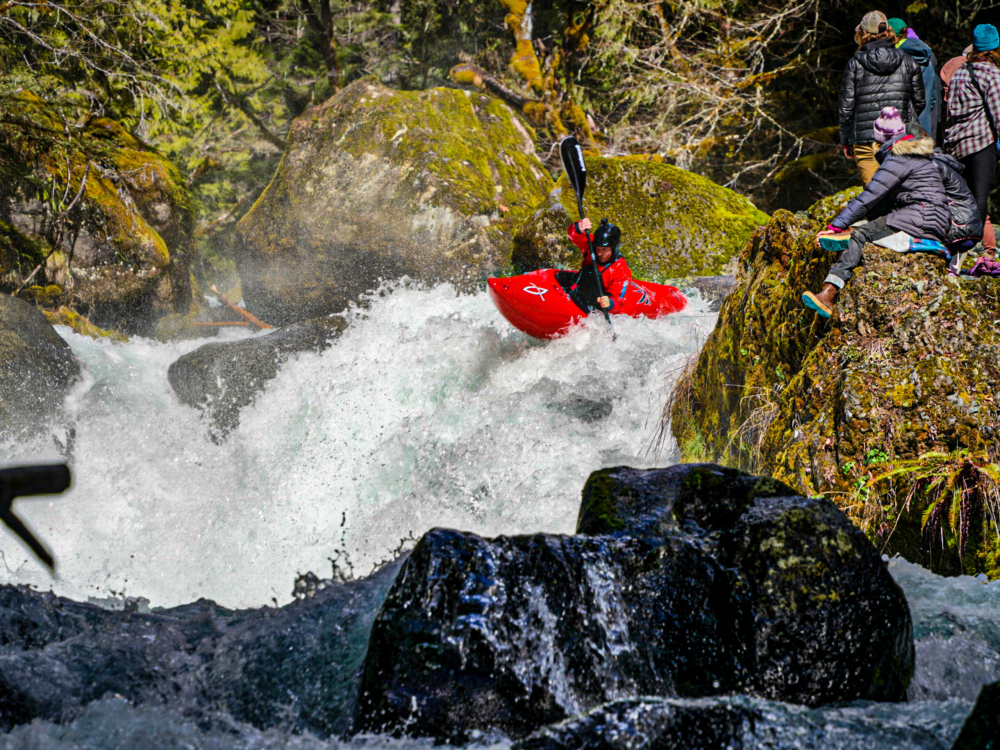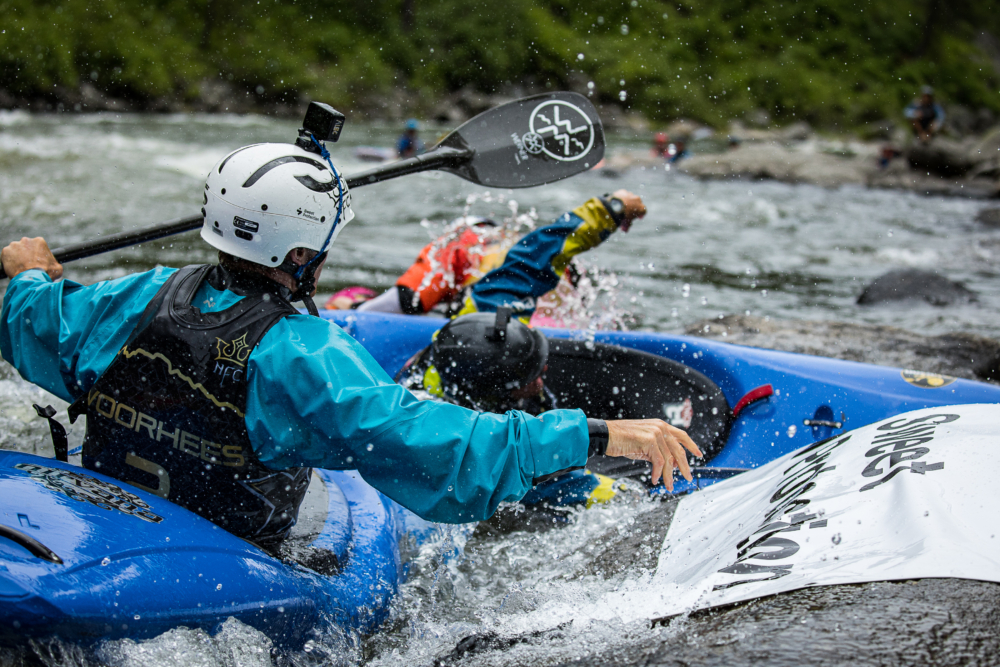The North Fork Championship. The Oetz Trophy. The King of the Alps. The Little White Race. The Go Pro Games. Events and races have long been a rallying point for the kayak community to get together and have fun, challenge themselves, and maybe earn some prize money to fund the next season. While they are still all these things, whitewater racing has become more and more professional over the past few years, and more and more athletes are preparing and training to top the winner’s podium. But what does that preparation look like, and what does it take to win? The short answer is, it depends on the race! The long answer… well, here are a few insights and tips on how to prepare and train for whitewater races.



Before you can start your preparation, you need to know what you’re preparing for. The first thing you need is a goal. Start by picking a race or a period of time when you want to be in the best shape. Secondly, consider what “the best shape” means for your specific goal. What skills are important to be fast in the race?
Maybe your goal is the Oetz Trophy, a 60 (ish)-second race where you have to hammer down a Class V pool-drop course with a lot of critical strokes. Your “best shape” for this race requires being strong at whitewater paddling and super explosive, with high strength endurance and a high lactic tolerance.
If you want to win the mass start at the Devils Extreme Race, where you face a 30-minute Class III-IV section with continuous wavy style, you need a different “best shape.” A lot of endurance, being light and quick, with experience maneuvering around other boaters. Once you have your goal and know what you want to prepare for, you can make a training plan for both long and short-term preparation.

Long Term Preparation
Long-term preparation can start as early as eight months before a race and is used to develop your general fitness and technique. Most athletes plan their long-term preparation in cycles. One cycle usually is about a month long. In each cycle, you pick three to four different aspects to train. Those aspects could be skills like max strength, basic endurance, sprinting, lactic tolerance, etc.
Each cycle should be a bit different to give your body some variation. But within one cycle, you want to have a routine where you repeat the same sessions to let your body adapt. Plan your long-term cycles by deciding what skills are the most important for you. Keep in mind that the better you get at a skill, the slower the progress. For example, say you train max strength for three months. The first month, your weekly progress in pull-ups is 5 kg. The third month, you only get stronger by 1 kg per week. This means that even if max strength is one of your most important skills, at some point, you will benefit more from working on a less important skill, if only because the rate of progress is so much higher.


This is where the planning gets complicated. How much effort do you want to put into each skill to reach your best shape? This balance is super individualized and not easy to figure out. Finding a coach who can help you figure out how to divide and reach those goals is a great resource. As an example, here’s an outline of a long-term preparation plan for a two-minute race in June:
Dec-Jan: Basic endurance, Hypertrophy, Technique
Feb-March: VO2 Max, Max Strength, Sprints
April-May: Lactic Tolerance, Strength Endurance, Sprints



Short-term Preparation
Two weeks before the race, we switch to short-term preparation. Opposite to what a lot of people think, now is not the time to work on your fitness—this is why you do long-term preparation. The last two weeks before the race, you want to focus on recovery, perfecting the lines, coming up with a strategy, considering your mental approach, etc.
Your short-term preparation is highly specific to the race you are focusing on. The more you can prep for a specific course, etc., the better. But to give you the basic idea, I’ll focus more generally on how to structure short-term prep for two different race styles: Time Trial and Boatercross.

Time Trial
In the time trial, it’s only you and the course. This is why the main focus is on perfecting THE fastest line. That’s where the time is hidden. There are three steps to master THE fastest line: Finding the fastest line, doing it consistently, and learning how to nail the line with the least amount of effort.
Start by scouting the course. Often, you will be able to tell where you want to go by looking. Then there are places where you just can’t see which line could be faster. Those are our key spots—time to jump in the boat and try it out. Run both lines and see how it feels. Try racing a friend on both or record each line with a GoPro and stop the time. Once you know what lines are the fastest, we want to nail them every time!

Next, paddle the whole run a few times and get a feel for it. Then, split the courses into pieces and focus on each part separately. This allows you to practice all parts of the course in race speed (which is important for timing and technique) without getting too tired. Alternate the sections where you push hard so you know what it’s like to paddle tired on each lap, or walk up and repeat moves over and over on the same lap. Visualize how to put all the sections together in your head.



It might happen that you can’t make it further than this step on a certain course. Maybe the moves are too hard, and you never manage to make them consistently. That’s okay! But if you do, you can work on the final step, figuring out how to use the least energy and still nail the lines. This is very tricky and takes a lot of experience and trial and error. For example, sometimes in waves, you are as fast when you sprint like crazy as you are when you cruise and use the momentum of the waves. Or sometimes, if you use a little bit more energy in the lead-in, it can save you way more energy afterward because you come in with more speed.


Experiment! Use a GoPro and spend time watching and analyzing your footage. Ask friends to compare lines or runs—they may see something you’re missing. Watching and filming how other people are approaching the course or moves can be helpful, but remember that everyone has different skills, comfort levels, and approaches to training.
Lastly, do a few race simulation runs. These will give you a better understanding of how to pace yourself so you don’t get tired too quickly or reach the finish with tons of energy left. It can be tempting to do lap after lap after lap but keep in mind that you need to be well-rested for the race, so don’t overdo it. A good indicator that you have a good rest/train balance is that you feel fresh and well-rested in the morning for the last two weeks before the race. You can always spend time watching from the sidelines, looking at footage, and visualizing your ideal line: All help with racing without fatiguing your muscles.

Additionally, consider topics like nutrition, scheduling your training sessions, etc. You probably know what foods make you feel good. Try to eat easily digestible food the last few days before the race, while adding more carbs into your diet than usual. This enables your body to fill your carbohydrate stores and gives you more glycogen to feed your muscles.
How you schedule your training sessions is up to you, but a safe approach is to do one or two short sessions a day with long breaks in between. To sum it up, go figure out your race line, break it down, repeat it until you know it and feel comfortable with the moves, eat like a king, recover until your energy shoots out of you, and then send that race!


Boatercross
In boatercross, there are multiple kayakers on the course at the same time. This makes things a lot different. Now there still is THE fastest line, but maybe it is going to be blocked by one of your competitors. This means we first look for the fastest line, which is going to be our preferred way. We do this the same way as we did in the Time Trial preparation. But instead of spending too much time perfecting the fastest line, start looking at backup lines. Ideally, you know all the lines on the course, so go ahead and paddle every variation of lines you can find. It can be very helpful to rally a practice run with multiple paddlers. The more situations you see in the practice, the more you are ahead of things in the race.



The start is critically important with so many racers on the water at once. You need to sprint to get out ahead early. This means you will be more tired earlier in the race than in a time trial. You will feel more lactic and more fatigued in the rapids, which makes them a lot harder. Make sure to practice all of the rapids being fatigued as well. Take a few practice laps where you sprint the start and then try to finish the rest of the course completely drained. That way, you know what spots require extra focus. But these laps will make you super tired, so don’t do too many!
When it comes to scheduling your training sessions, you might try having longer sessions. This would help do some runs when you’re super tired, which is good training. But then you will need more recovery in between the sessions or even fewer sessions.



After you’ve worked out your lines, it’s time to think about strategy. For example, look at the course and find spots where you can overtake others or take care not to get overtaken. There might be spots where it is nice to have some distance so others can’t mess with your lines. Or maybe there are places where you could mess up the lines of others to overtake them.

As far as the rest of the strategy, treat nutrition and recovery the same as a time trial. Eat easily digestible foods and a lot of carbs, and prioritize recovery time. The last bit might sound obvious, but make sure you know what the rules are for a race. For example, what are the penalties for missing or touching a gate? Do you need your whole boat to go through a gate, or just your head and neck? Are there any penalties or illegal moves? Check out the start line and the finish line so you don’t stop racing too soon or get yourself disqualified. It can happen!
Now, back to step one. Pick a race, and let’s get into shape. If you need help with your planning, feel free to contact Andi Brunner. He offers individual coaching plans for both long-term and short-term preparations.



***
Guest Contributor, Andi Brunner is Team NRS and Jackson Kayak paddler, a European Cup race winner (2018) and two-time Vice European Extreme Race Champion (2019, 2021). Always sporting a giant smile and infectious enthusiasm, when he’s not racing or training, Andi coaches kayaking for Source to Sea in Innsbruck, Austria.